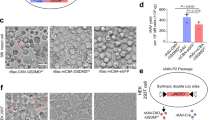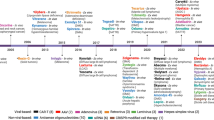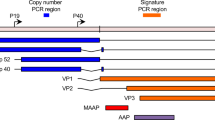Abstract
The ganglioside GM3(Neu5Gc) has gained increasing attention as therapeutic target because of its selective expression in various human tumours, such as melanoma, breast and lung cancer. 14F7 is a mouse IgG1 with specific reactivity to GM3(Neu5Gc)-positive tumours. The therapeutic activity of 14F7 has also been demonstrated in vivo, through its repetitive passive administration in tumour-bearing animals. In this work we used an alternative strategy to deliver recombinant 14F7 in vivo and analysed the therapeutic efficacy of this approach. We engineered a recombinant adeno-associated vector to direct the expression of secretable recombinant 14F7 in BALB/c animals. A single administration of the rAAV induced efficient production and secretion of the antibody in the bloodstream, with an expression level reaching plateau at ∼3 weeks after injection and persisting for almost a year. Strikingly, upon challenge with GM3(Neu5Gc)-positive X63-AG8.653 myeloma cells, tumour development was significantly delayed in animals treated with rAAV-14F7 with respect to animals treated with a control rAAV codifying for an irrelevant antibody. Finally, no significant differences in survival proportion were detected in animals injected with rAAV-14F7 or treated by standard administration of repetitive doses of purified monoclonal antibody 14F7.
This is a preview of subscription content, access via your institution
Access options
Subscribe to this journal
Receive 6 print issues and online access
$259.00 per year
only $43.17 per issue
Buy this article
- Purchase on SpringerLink
- Instant access to full article PDF
Prices may be subject to local taxes which are calculated during checkout





Similar content being viewed by others
References
Lopez PH, Schnaar RL . Gangliosides in cell recognition and membrane protein regulation. Curr Opin Struct Biol 2009; 19: 549–557.
Regina TA, Hakomori SI . Functional role of glycosphingolipids and gangliosides in control of cell adhesion, motility, and growth, through glycosynaptic microdomains. Biochim Biophys Acta 2008; 1780: 421–433.
de LJ, Fernandez A, Mesa C, Clavel M, Fernandez LE . Role of tumour-associated N-glycolylated variant of GM3 ganglioside in cancer progression: effect over CD4 expression on T cells. Cancer Immunol Immunother 2006; 55: 443–450.
Liu Y, Wondimu A, Yan S, Bobb D, Ladisch S . Tumor gangliosides accelerate murine tumor angiogenesis. Angiogenesis 2013; 17: 563–571.
Peguet-Navarro J, Sportouch M, Popa I, Berthier O, Schmitt D, Portoukalian J . Gangliosides from human melanoma tumors impair dendritic cell differentiation from monocytes and induce their apoptosis. J Immunol 2003; 170: 3488–3494.
de LJ, Fernandez A, Clavell M, Labrada M, Bebelagua Y, Mesa C et al. Differential influence of the tumour-specific non-human sialic acid containing GM3 ganglioside on CD4+. Int Immunol 2008; 20: 591–600.
Portoukalian J, Zwingelstein G, Dore JF . Lipid composition of human malignant melanoma tumors at various levels of malignant growth. Eur J Biochem 1979; 94: 19–23.
Pukel CS, Lloyd KO, Travassos LR, Dippold WG, Oettgen HF, Old LJ . GD3, a prominent ganglioside of human melanoma. Detection and characterisation by mouse monoclonal antibody. J Exp Med 1982; 155: 1133–1147.
Hettmer S, Ladisch S, Kaucic K . Low complex ganglioside expression characterizes human neuroblastoma cell lines. Cancer Lett 2005; 225: 141–149.
Cheung NK, Saarinen UM, Neely JE, Landmeier B, Donovan D, Coccia PF . Monoclonal antibodies to a glycolipid antigen on human neuroblastoma cells. Cancer Res 1985; 45: 2642–2649.
Irie A, Koyama S, Kozutsumi Y, Kawasaki T, Suzuki A . The molecular basis for the absence of N-glycolylneuraminic acid in humans. J Biol Chem 1998; 273: 15866–15871.
Higashi H, Hirabayashi Y, Fukui Y, Naiki M, Matsumoto M, Ueda S et al. Characterization of N-glycolylneuraminic acid-containing gangliosides as tumor-associated Hanganutziu-Deicher antigen in human colon cancer. Cancer Res 1985; 45: 3796–3802.
Hirabayashi Y, Higashi H, Kato S, Taniguchi M, Matsumoto M . Occurrence of tumor-associated ganglioside antigens with Hanganutziu-Deicher antigenic activity on human melanomas. Jpn J Cancer Res 1987; 78: 614–620.
Marquina G, Waki H, Fernandez LE, Kon K, Carr A, Valiente O et al. Gangliosides expressed in human breast cancer. Cancer Res 1996; 56: 5165–5171.
Banda K, Gregg CJ, Chow R, Varki NM, Varki A . Metabolism of vertebrate amino sugars with N-glycolyl groups: mechanisms underlying gastrointestinal incorporation of the non-human sialic acid xeno-autoantigen N-glycolylneuraminic acid. J Biol Chem 2012; 287: 28852–28864.
Bardor M, Nguyen DH, Diaz S, Varki A . Mechanism of uptake and incorporation of the non-human sialic acid N-glycolylneuraminic acid into human cells. J Biol Chem 2005; 280: 4228–4237.
Tangvoranuntakul P, Gagneux P, Diaz S, Bardor M, Varki N, Varki A et al. Human uptake and incorporation of an immunogenic nonhuman dietary sialic acid. Proc Natl Acad Sci USA 2003; 100: 12045–12050.
Yin J, Hashimoto A, Izawa M, Miyazaki K, Chen GY, Takematsu H et al. Hypoxic culture induces expression of sialin, a sialic acid transporter, and cancer-associated gangliosides containing non-human sialic acid on human cancer cells. Cancer Res 2006; 66: 2937–2945.
Yin J, Miyazaki K, Shaner RL, Merrill AH Jr, Kannagi R . Altered sphingolipid metabolism induced by tumor hypoxia - new vistas in glycolipid tumor markers. FEBS Lett 2010; 584: 1872–1878.
Fernandez LE, Gabri MR, Guthmann MD, Gomez RE, Gold S, Fainboim L et al. NGcGM3 ganglioside: a privileged target for cancer vaccines. Clin Dev Immunol 2010; 2010: 814397.
Carr A, Mullet A, Mazorra Z, Vazquez AM, Alfonso M, Mesa C et al. A mouse IgG1 monoclonal antibody specific for N-glycolyl GM3 ganglioside recognized breast and melanoma tumors. Hybridoma 2000; 19: 241–247.
Blanco R, Rengifo E, Rengifo CE, Cedeno M, Frometa M, Carr A . Immunohistochemical reactivity of the 14F7 monoclonal antibody raised against N-glycolyl GM3 ganglioside in some benign and malignant skin neoplasms. ISRN Dermatol 2011; 2011: 848909.
Blanco R, Rengifo CE, Cedeno M, Frometa M, Rengifo E, Carr A . Immunoreactivity of the 14F7 Mab (raised against N-glycolyl GM3 ganglioside) as a positive prognostic factor in non-small-cell lung cancer. Patholog Res Int 2012; 2012: 235418.
Blanco R, Blanco D, Quintana Y, Escobar X, Rengifo CE, Osorio M et al. Immunoreactivity of the 14F7 Mab raised against N-glycolyl GM3 ganglioside in primary lymphoid tumors and lymph node metastasis. Patholog Res Int 2013; 2013: 920972.
Blanco R, Rengifo E, Cedeno M, Rengifo CE, Alonso DF, Carr A . Immunoreactivity of the 14F7 Mab raised against N-glycolyl GM3 ganglioside in epithelial malignant tumors from digestive system. ISRN Gastroenterol 2011; 2011: 645641.
Carr A, Mesa C, del Carmen AM, Vazquez AM, Fernandez LE . In vivo and in vitro anti-tumor effect of 14F7 monoclonal antibody. Hybrid Hybridomics 2002; 21: 463–468.
Roque-Navarro L, Chakrabandhu K, de LJ, Rodriguez S, Toledo C, Carr A et al. Anti-ganglioside antibody-induced tumor cell death by loss of membrane integrity. Mol Cancer Ther 2008; 7: 2033–2041.
Fernandez-Marrero Y, Lopez-Requena A . Lonely killers: effector cell- and complement-independent non-proapoptotic cytotoxic antibodies inducing membrane lesions. MAbs 2011; 3: 528–534.
Lu Y . Recombinant adeno-associated virus as delivery vector for gene therapy–a review. Stem Cells Dev 2004; 13: 133–145.
Schnepp BC, Clark KR, Klemanski DL, Pacak CA, Johnson PR . Genetic fate of recombinant adeno-associated virus vector genomes in muscle. J Virol 2003; 77: 3495–3504.
Penaud-Budloo M, Le GC, Nowrouzi A, Toromanoff A, Cherel Y, Chenuaud P et al. Adeno-associated virus vector genomes persist as episomal chromatin in primate muscle. J Virol 2008; 82: 7875–7885.
Nakai H, Yant SR, Storm TA, Fuess S, Meuse L, Kay MA . Extrachromosomal recombinant adeno-associated virus vector genomes are primarily responsible for stable liver transduction in vivo. J Virol 2001; 75: 6969–6976.
Nathwani AC, Tuddenham EG, Rangarajan S, Rosales C, McIntosh J, Linch DC et al. Adenovirus-associated virus vector-mediated gene transfer in hemophilia B. N Engl J Med 2011; 365: 2357–2365.
Wagner JA, Nepomuceno IB, Messner AH, Moran ML, Batson EP, Dimiceli S et al. A phase II, double-blind, randomized, placebo-controlled clinical trial of tgAAVCF using maxillary sinus delivery in patients with cystic fibrosis with antrostomies. Hum Gene Ther 2002; 13: 1349–1359.
Bessis N, Doucet C, Cottard V, Douar AM, Firat H, Jorgensen C et al. Gene therapy for rheumatoid arthritis. J Gene Med 2002; 4: 581–591.
MacLaren RE, Groppe M, Barnard AR, Cottriall CL, Tolmachova T, Seymour L et al. Retinal gene therapy in patients with choroideremia: initial findings from a phase 1/2 clinical trial. Lancet 2014; 383: 1129–1137.
Balazs AB, Chen J, Hong CM, Rao DS, Yang L, Baltimore D . Antibody-based protection against HIV infection by vectored immunoprophylaxis. Nature 2012; 481: 81–84.
Balazs AB, Bloom JD, Hong CM, Rao DS, Baltimore D . Broad protection against influenza infection by vectored immunoprophylaxis in mice. Nat Biotechnol 2013; 31: 647–652.
Deal C, Balazs AB, Espinosa DA, Zavala F, Baltimore D, Ketner G . Vectored antibody gene delivery protects against Plasmodium falciparum sporozoite challenge in mice. Proc Natl Acad Sci USA 2014; 111: 12528–12532.
Fang J, Qian JJ, Yi S, Harding TC, Tu GH, VanRoey M et al. Stable antibody expression at therapeutic levels using the 2A peptide. Nat Biotechnol 2005; 23: 584–590.
Patel P, Kriz J, Gravel M, Soucy G, Bareil C, Gravel C et al. Adeno-associated virus-mediated delivery of a recombinant single-chain antibody against misfolded superoxide dismutase for treatment of amyotrophic lateral sclerosis. Mol Ther 2014; 22: 498–510.
Rosenberg JB, Hicks MJ, De BP, Pagovich O, Frenk E, Janda KD et al. AAVrh.10-mediated expression of an anti-cocaine antibody mediates persistent passive immunization that suppresses cocaine-induced behavior. Hum Gene Ther 2012; 23: 451–459.
Wang G, Qiu J, Wang R, Krause A, Boyer JL, Hackett NR et al. Persistent expression of biologically active anti-HER2 antibody by AAVrh.10-mediated gene transfer. Cancer Gene Ther 2010; 17: 559–570.
Ryan MD, Drew J . Foot-and-mouth disease virus 2A oligopeptide mediated cleavage of an artificial polyprotein. EMBO J 1994; 13: 928–933.
Casadesus AV, Fernandez-Marrero Y, Clavell M, Gomez JA, Hernandez T, Moreno E et al. A shift from N-glycolyl- to N-acetyl-sialic acid in the GM3 ganglioside impairs tumor development in mouse lymphocytic leukemia cells. Glycoconj J 2013; 30: 687–699.
Sliwkowski MX, Mellman I . Antibody therapeutics in cancer. Science 2013; 341: 1192–1198.
Inagaki K, Fuess S, Storm TA, Gibson GA, Mctiernan CF, Kay MA et al. Robust systemic transduction with AAV9 vectors in mice: efficient global cardiac gene transfer superior to that of AAV8. Mol Ther 2006; 14: 45–53.
Rodriguez M, Roque-Navarro L, Lopez-Requena A, Moreno E . Insights into the immunogenetic basis of two ganglioside-associated idiotypic networks. Immunobiology 2007; 212: 57–70.
Boligan KF, Mesa C, Fernandez LE, von GS . Cancer intelligence acquired (CIA): tumor glycosylation and sialylation codes dismantling antitumor defense. Cell Mol Life Sci 2015; 72: 1231–1248.
Potapenko M, Shurin GV, de LJ . Gangliosides as immunomodulators. Adv Exp Med Biol 2007; 601: 195–203.
Hedlund M, Padler-Karavani V, Varki NM, Varki A . Evidence for a human-specific mechanism for diet and antibody-mediated inflammation in carcinoma progression. Proc Natl Acad Sci USA 2008; 105: 18936–18941.
Pearce OM, Laubli H, Verhagen A, Secrest P, Zhang J, Varki NM et al. Inverse hormesis of cancer growth mediated by narrow ranges of tumor-directed antibodies. Proc Natl Acad Sci USA 2014; 111: 5998–6003.
Mulens V, de la Torre A, Marinello P, Rodriguez R, Cardoso J, Diaz R et al. Immunogenicity and safety of a NeuGcGM3 based cancer vaccine: results from a controlled study in metastatic breast cancer patients. Hum Vaccin 2010; 6: 736–744.
Osorio M, Gracia E, Reigosa E, Hernandez J, de la Torre A, Saurez G et al. Effect of vaccination with N-glycolyl GM3/VSSP vaccine by subcutaneous injection in patients with advanced cutaneous melanoma. Cancer Manag Res 2012; 4: 341–345.
Hernandez AM, Toledo D, Martinez D, Grinan T, Brito V, Macias A et al. Characterization of the antibody response against NeuGcGM3 ganglioside elicited in non-small cell lung cancer patients immunized with an anti-idiotype antibody. J Immunol 2008; 181: 6625–6634.
Alfonso S, Valdes-Zayas A, Santiesteban ER, Flores YI, Areces F, Hernandez M et al. A randomized, multicenter, placebo-controlled clinical trial of racotumomab-alum vaccine as switch maintenance therapy in advanced non-small cell lung cancer patients. Clin Cancer Res 2014; 20: 3660–3671.
Donnelly ML, Gani D, Flint M, Monaghan S, Ryan MD . The cleavage activities of aphthovirus and cardiovirus 2A proteins. J Gen Virol 1997; 78: 13–21.
Deodato B, Arsic N, Zentilin L, Galeano M, Santoro D, Torre V et al. Recombinant AAV vector encoding human VEGF165 enhances wound healing. Gene Therapy 2002; 9: 777–785.
Alfonso M, Vazquez AM, Carr A, Haerslev T, Fernandez LE, Lanio ME et al. T cell-independent B cell response to self-monosialogangliosides: primary response monoclonal antibodies. Hybridoma 1995; 14: 209–216.
Lopez-Requena A, Bestagno M, Mateo de AC, Cesco-Gaspere M, Vazquez AM, Perez R et al. Gangliosides, Ab1 and Ab2 antibodies III. The idiotype of anti-ganglioside mAb P3 is immunogenic in a T cell-dependent manner. Mol Immunol 2007; 44: 2915–2922.
Acknowledgements
This work was supported in part by the Center of Molecular Immunology, Havana, Cuba. M C-G was supported in part by Fondo Trieste to Molecular Immunology, International Centre for Genetic Engineering and Biotechnology (ICGEB), Trieste. AP was supported in part by an ICGEB predoctoral fellowship. We thank Marina Dapas from ICGEB for excellent technical assistance and Dr Kayluz Frias Boligan from the Institute of Pharmacology, University of Bern, Switzerland, for help with cell lines.
Author information
Authors and Affiliations
Corresponding authors
Ethics declarations
Competing interests
The authors declare no conflict of interest.
Additional information
Supplementary Information accompanies this paper on Gene Therapy website
Supplementary information
Rights and permissions
About this article
Cite this article
Piperno, G., López-Requena, A., Predonzani, A. et al. Recombinant AAV-mediated in vivo long-term expression and antitumour activity of an anti-ganglioside GM3(Neu5Gc) antibody. Gene Ther 22, 960–967 (2015). https://doi.org/10.1038/gt.2015.71
Received:
Revised:
Accepted:
Published:
Issue date:
DOI: https://doi.org/10.1038/gt.2015.71



